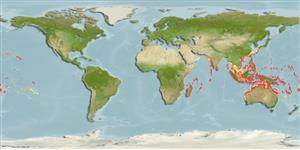Common names from other countries
Issue
Indian Ocean species refers to C. nigripinnis; reference needed (N.Bailly pers.comm., 02/2019).
Environment: milieu / climate zone / depth range / distribution range
Οικολογία
Θαλασσινό(ά) Υφαλόφιλο(α); εύρος βάθους 0 - 60 m (Ref. 5222), usually 3 - 15 m (Ref. 9710). Tropical; 34°N - 30°S, 33°E - 131°W (Ref. 5222)
Pacific Ocean: eastward to French Polynesia and the Pitcairn Islands, and to Christmas Isalnd in the Indian Ocean
Length at first maturity / Μέγεθος / Βάρος / Age
Maturity: Lm ?, range 17 - ? cm
Max length : 28.0 cm TL αρσενικό/απροσδιόριστο; (Ref. 5222)
Ραχιαίες άκανθες (συνολικά) : 9; Μαλακές ραχιαίες ακτίνες (συνολικά) : 14 - 16; Εδρικές άκανθες: 3; Μαλακές εδρικές ακτίνες: 8 - 9. This species is distinguished by the following characteristics: greatest body depth 2.7-3.1 in standard length; body scales ctenoid except cycloid scales ventrally on abdomen; rounded caudal fin; pelvic fins usually not reaching the anus, 1.8-2.2 in head length Colour of body reddish brown anteriorly, dark brown posteriorly; caudal fin with 2 white to bluish white bands that converge posteriorly (Ref. 90102).
Adults inhabit clear, shallow waters of outer reef areas, in lagoons, back-reef areas, and on the reef-top. As solitary individuals (Ref. 90102), they prefer healthy coral reef in shallow areas, and are therefore greatly affected by reef degradation (Ref. 89707). They feed on small fishes (68%) and crustaceans. Because of its small size, the darkfin hind is not of much interest as a food fish (except perhaps to subsistence fisheries), but it does well in an aquarium and may find a market as an aquarium fish. They are caught with hook-and-line, gill nets, and in traps (Ref. 39231). Minimum depth reported taken from Ref. 128797.
Life cycle and mating behavior
Maturities | Αναπαραγωγή | Spawnings | Egg(s) | Fecundities | Προνύμφες
Protogyny is unconfirmed for this species (Ref. 103751).
Heemstra, P.C. and J.E. Randall, 1993. FAO Species Catalogue. Vol. 16. Groupers of the world (family Serranidae, subfamily Epinephelinae). An annotated and illustrated catalogue of the grouper, rockcod, hind, coral grouper and lyretail species known to date. Rome: FAO. FAO Fish. Synop. 125(16):382 p. (Ref. 5222)
IUCN Red List Status (Ref. 130435)
CITES (Ref. 128078)
Not Evaluated
Threat to humans
Harmless
Human uses
αλιεία: παραδοσιακή αλιεία; Ενυδρείο: Δυνητικό
Εργαλεία
Special reports
Download XML
Διαδικτυακές πηγές
Estimates based on models
Preferred temperature (Ref.
115969): 25.2 - 29.3, mean 28.4 (based on 3224 cells).
Phylogenetic diversity index (Ref.
82804): PD
50 = 0.5000 [Uniqueness, from 0.5 = low to 2.0 = high].
Bayesian length-weight: a=0.01230 (0.00759 - 0.01994), b=3.04 (2.90 - 3.18), in cm Total Length, based on LWR estimates for this species & Genus-body shape (Ref.
93245).
Τροφικό Επίπεδο (Ref.
69278): 4.0 ±0.69 se; based on food items.
Ελαστικότητα (Ref.
120179): Υψηλό, ελάχιστος χρόνος για διπλασιασμό πληθυσμού < 15 μήνες (Preliminary K or Fecundity.).
Fishing Vulnerability (Ref.
59153): Low vulnerability (14 of 100).
